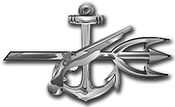Special Warfare insignia
| Special Warfare Insignia | |
|---|---|
 | |
| Type | Single-grade badge |
| Eligibility | United States Navy SEALs |
| Awarded for | Completing Basic Underwater Demolitions/SEAL training and SEAL Qualification Training |
| Statistics | |
| Established | 1970 |
| First awarded | Vietnam War |

The Special Warfare insignia, also known as the “SEAL Trident” or its more popular nickname, "The Budweiser" is earned after completion of BUD/S and SQT, is one of the most recognizable military badges of the United States Navy.
History
Established on 16 October 1970,[1] the insignia recognizes those service members who have completed the Navy’s Basic Underwater Demolition/SEAL (BUD/S) training, completed SEAL Qualification Training and have been designated as U.S. Navy SEALs.
The Special Warfare insignia was initially issued in two grades, being a gold badge for officers and silver for enlisted. In the 1970s, the Silver SEAL badge was abolished and the Special Warfare Badge was issued thereafter in a single grade. The SEAL badge is therefore unusual in the Navy in that it is one of the few badges issued in a single grade for both officers and enlisted personnel. This is partly due to the combined training that both officers and enlisted receive, side by side, when involved in BUD/S training.
The Special Warfare insignia consists of a golden eagle clutching a U.S. Navy anchor, trident, and flintlock style pistol. The decoration is considered a "successor badge" to the obsolete Underwater Demolition Badge.
Designator and title
An enlisted sailor who qualifies for the Special Warfare insignia is authorized to place the designator (SEAL) after his rating. At the end of 2006, all sailors having completed SEAL training and still serving in Naval Special Warfare had their ratings reclassified to Special Warfare Operator (SO), with a new rating badge. Previously there were more than 20 ratings which SEAL operators could have.
See also
- List of United States Navy enlisted warfare designations
- Badges of the United States Navy
- Military badges of the United States
- Obsolete badges of the United States military
- Uniforms of the United States Navy
Notes
- ↑ Cummings, Dennis J. The Men Behind the Trident: SEAL Team One in Vietnam. Naval Institute Press, 1997, p. 16.
References
- National Archives and Records Administration, Military Personnel Records Center (U.S. Navy Breast Insignia Descriptions)